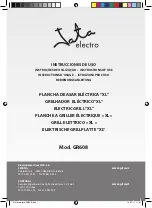
9 ENGLISH
Reversing switch action
►
Fig.6:
1.
Reversing switch lever
CAUTION:
Always check the direction of
rotation before operation.
CAUTION:
Use the reversing switch only after
the tool comes to a complete stop.
Changing the
direction of rotation before the tool stops may dam
-
age the tool.
CAUTION:
When not operating the tool,
always set the reversing switch lever to the neu
-
tral position.
This tool has a reversing switch to change the direction
of rotation. Depress the reversing switch lever from the
A side for clockwise rotation or from the B side for coun
-
terclockwise rotation.
When the reversing switch lever is in the neutral posi-
tion, the switch trigger cannot be pulled.
Speed change
►
Fig.7:
1.
Speed change lever
CAUTION:
Always set the speed change lever
fully to the correct position.
If you operate the
tool with the speed change lever positioned halfway
between the “1” side and “2” side, the tool may be
damaged.
CAUTION:
Do not use the speed change lever
while the tool is running.
The tool may be damaged.
Position of
speed
change lever
Speed
Torque
Applicable
operation
1
Low
High
Heavy load
-
ing operation
2
High
Low
Light loading
operation
To change the speed, switch off the tool first. Select
the “2” side for high speed or “1” for low speed but high
torque. Be sure that the speed change lever is set to the
correct position before operation.
If the tool speed is coming down extremely during the
operation with “2”, slide the lever to the “1” and restart
the operation.
Selecting the action mode
NOTICE:
Always set the ring correctly to your
desired mode mark. If you operate the tool with the
ring positioned halfway between the mode marks, the
tool may be damaged.
NOTICE:
Do not change the action mode while
rotating.
►
Fig.8:
1.
Action mode changing ring
2.
Mark
3.
Arrow
This tool has two action modes.
•
Drilling mode (rotation only)
•
Screwdriving mode (rotation with clutch)
Select one mode suitable for your work. Turn the
action mode changing ring and align the mark that you
selected with the arrow on the tool body.
Adjusting the fastening torque
►
Fig.9:
1.
Adjusting ring
2.
Action mode changing
ring
3.
Graduation
4.
Arrow
The fastening torque can be adjusted in 21 levels by
turning the adjusting ring. You can get the minimum
fastening torque at 1 and maximum torque at 21.
1.
Align
marking with the arrow on the tool body
by turning the action mode changing ring.
2.
Align the graduations with the arrow on the tool
body by turning the adjusting ring.
Before actual operation, drive a trial screw into your
material or a piece of duplicate material to deter-
mine which torque level is required for a particular
application.
ASSEMBLY
CAUTION:
Always be sure that the tool is
switched off and the battery cartridge is removed
before carrying out any work on the tool.
Installing side grip (auxiliary handle)
►
Fig.10:
1.
Groove
2.
Steel band
3.
Protrusion
4.
Grip base
5.
Side grip
Always use the side grip to ensure operating safety.
Attach the side grip so that the protrusions on the grip
base and steel band fit in the grooves on the tool barrel.
Then tighten the grip by turning clockwise.
Depending the operations, you can attach the side grip
upward or right/left side of the tool.
Installing or removing driver bit/
drill bit
►
Fig.11:
1.
Sleeve
Turn the sleeve counterclockwise to open the chuck
jaws. Place the driver bit/drill bit in the chuck as far
as it will go. Turn the sleeve clockwise to tighten the
chuck. To remove the driver bit/drill bit, turn the sleeve
counterclockwise.
Installing driver bit holder
Optional accessory
►
Fig.12:
1.
Driver bit holder
2.
Driver bit
Fit the driver bit holder into the protrusion at the tool foot
on either right or left side and secure it with a screw.
When not using the driver bit, keep it in the driver bit
holders. Driver bits 45 mm-long can be kept there.










































